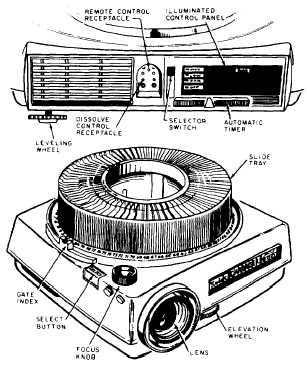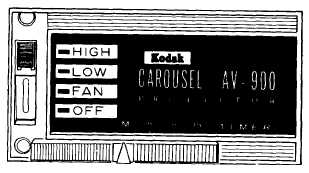bent or broken slide catches in the gate, you can
remove the locking ring on the slide tray, depress
the select button, and remove the defective slide.
The round slide tray, accommodating 80
slides, is placed upright on top of the projector,
as shown in figure 7-12. As the slide tray
revolves, the number of the slide being shown
appears opposite the gate index on the projector.
CONTROLS.—The operation and adjust-
ment controls are shown in figures 7-12 and
7-13. The important operation and adjustment
controls are given in the following sub-
paragraphs.
a. The automatic timer has four settings: M
(manual), 5, 8, and 15 seconds. The
changing mechanism is set in motion
matically when the automatic timer is set
slide-
auto-
at the
287.26(M1)
Figure 7-13.—Control panel.
5, 8, or 15 setting. Slides are shown on the
screen for the number of seconds indicated by
the automatic timer. Rapid advancement be-
tween slides eliminates long dark-screen periods.
b. The SELECT button (figure 7-12), lets
you show (or sequence) single slides without the
slide tray, show an individual slide out of
sequence, or retrieve a slide from the gate. You
287.25(M1)
Figure 7-12.—Carousel, Model AV-900 35-mm slide
projector.
also use this control when removing the slide
tray.
c. The selector switch on the control panel
(figures 7-12 and 7-13) may be placed at either of
four positions. In the OFF position, the projec-
tor is completely turned off. In the FAN posi-
tion, the fan operates with the projection lamp
turned off, The HIGH and LOW positions pro-
vide a choice of brilliance for different projec-
tion conditions. (Longer lamp life is obtained
when the LOW position is used.)
d. The elevation knob (figure 7-12) allows
you to center the height of the projected image
on the screen. The leveling wheel, located under
one of the back corners, levels the projector.
e. The focusing knob (figure 7-12) allows
you to focus the picture on the screen, as well as
easily remove the lens.
LENSES.—The projection lens will give a
brilliant, sharp picture under a wide range of
conditions. There are 3-, 4-, 5-, and 7-inch lenses
(8-, 10-, 13-, 18-cm), and a 4- to 6-inch zoom
lens (10- to 15-cm). The zoom lens lets you vary
the size of the projected image so that it fills the
7-22




